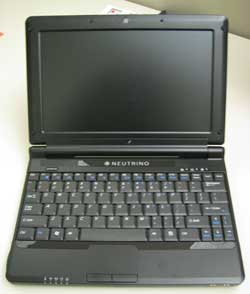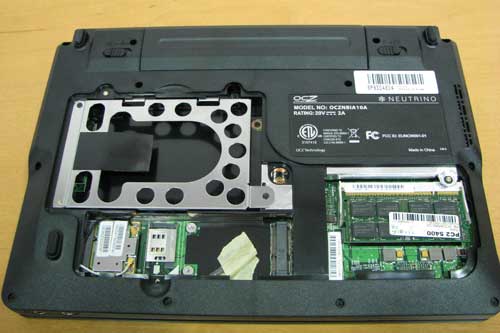Hands-On with the OCZ Neutrino DIY Netbook Kit

Ever since the Eee PC 701 hit the market back in the fall of 2007, a small but dedicated community of netbook hackers has been modding these diminutive systems. Intrepid modders have done everything from upgrading the RAM to installing new hard drives, Bluetooth antennas, mobile broadband, and even touchscreens. You might think the cost of parts would discourage consumers from adding even an $80 hard drive to a $350 notebook, but you'd be wrong. In fact, we've heard from users who have slapped in expensive SSDs, like the Intel X-25M, that cost more than most netbooks. It almost goes without saying that even more users have replaced the default operating systems. Users who upgrade their notebooks, as willing to spend money as they may be, hate the idea of paying for a notebook that comes with a hard drive they don't want, an operating system they don't want, or even a stick of RAM they don't want. Enter OCZ's Neutrino DIY netbook kit, a bare bones netbook that comes with a 10-inch 1024 x 600 screen, a 2200 mAh battery (we think it's a three cell), an Intel Atom N270 1.6GHz processor, Intel 945GSE integrated graphics, 802.11g wireless, a roomy keyboard, and a touchpad built-in. The only things missing are the RAM and the hard drive, which you install yourself. Chassis Today, a shiny new Neutrino arrived our office and we were able to do a quick hands-on with it before sending it off to the lab for testing. Our first impression of the Neutrino is that it has the exact same chassis as some other netbooks on the market, namely the Workhorse Certeza MC10. That's probably because this is a reference chassis that's made by a third party designer. Though the Neutrino's chassis is bland looking, it feels very light. Keyboard and Touchpad We like the size, feel, and placement of the keys on the keyboard. Unlike some other netbooks we've reviewed, the right shift key is directly adjacent to the slash key and all the function and quotation mark keys are in their proper locations. The keys are a solid size and offer solid tactile feedback. The touchpad, while a bit small, seems to have a nice surface. Its two touchpad buttons are correctly located below the pad and offer just the right amount of feedback when clicked. Ports The system comes with a VGA port, audio in and out, a Kensington lock, Ethernet, two USB ports, and an ExpressCard slot, a rarity among low-priced netbooks. We haven't tested the 1024 x 600 screen yet, but we think it may be the same panel that offers fantastic viewing angles on the Workhorse Certeza MC10. Upgradeability The underside of the system sports an easily accessible upgrade hatch. After removing five screws, you can pry it open to reveal a 2.5-inch SATA hard drive slot, a PC-5300 SO-DIMM RAM slot, and a free mini PCI-e slot. Though the system comes with an 802.11b/g card built in, we have to wonder whether the free mini PCI-e slot will support a mobile broadband card or mini PCI-e SSD like those made for the ASUS Eee PC or Dell Inspiron Mini 9.

Our next step is to pop in a hard drive, insert a 2GB DIMM, and install Windows XP to we can begin benchmarking the system. Stayed tuned for a review in the next day or two, but until then check out our video and image gallery below.
[flq:ff02480764cf4f4ca755246cd0226075]
Stay in the know with Laptop Mag
Get our in-depth reviews, helpful tips, great deals, and the biggest news stories delivered to your inbox.

